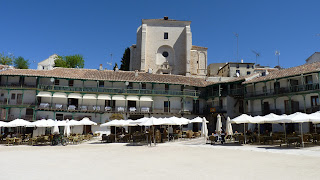 Aranjuez is
a 59,037 inhabitants town on the confluence of Tagus and Jarama rivers, southernmost town in Madrid region, in Spain. Aranjuez is places in the Royal Sites because it was always been very linked to the Spanish monarchy since the construction of the palace, being an inspiration for artists like the guitar concerto Concierto de Aranjuez by Joaquín Rodrigo. It was placed as a World Heritage Site by UNESCO in 2001.
Aranjuez is
a 59,037 inhabitants town on the confluence of Tagus and Jarama rivers, southernmost town in Madrid region, in Spain. Aranjuez is places in the Royal Sites because it was always been very linked to the Spanish monarchy since the construction of the palace, being an inspiration for artists like the guitar concerto Concierto de Aranjuez by Joaquín Rodrigo. It was placed as a World Heritage Site by UNESCO in 2001.How do I arrive to Aranjuez?
Aranjuez is very well connected both with Madrid and its metropolitan area and with some important cities in the south or east of Spain.
- Train: there are trains each 10-20 minutes to Aranjuez (aprox. 1 hour), in line C3, from Chamartín Railway Station for 4.05€ (one way) in Madrid. Aranjuez is an important railway connecting point so there are also daily Media Distancia trains to Jaén (aprox. 3 hours 15 minutes) and also to Valencia (aprox. 5 hours 30 minutes) via Cuenca (aprox. 2 hours) and via Albacete (aprox. 2 minutes).
- Bus: there are buses each 2 hours to Madrid (aprox. 1 hour) from Aranjuez Bus Station for 4.20€ (one way), reaching Méndez Álvaro Bus Station. There are also many buses to Toledo (aprox. 45 minutes) and buses to Chinchón (aprox. 50 minutes).
- Car: if you rented a car, it's 20 minutes from Colmenar de Oreja, 30 minutes journey from Chinchón, 40 minutes from Toledo, 50 minutes from Alcalá de Henares and 1 hour from Madrid.
History
What can I visit in Aranjuez?
Aranjuez is an interesting town and has many things to do here, but fortunatelly almost all of them are close to the main and central square, Plaza de Parejas.
- Royal Palace of Aranjuez (10-20 Tue-Sun from Apr to Mar; 10-18 Tue-Sun from Oct to Mar; 9€/ 4€/ free adults/ retiree, students and kids till 5/ kids under 5): this 16th century palace was the summer residence of the Spanish monarchy since Ferdinand VI of Spain. It was ordered by Philip II of Spain to the Renaissance architect Juan Bautista de Toledo and was popular among the kings for its closeness to hunting reserves. The most spectacular rooms are the Throne Room, the Porcelain Room, the Chinese Room and the Morish Room. It's free of charge on Wed and Thu afternoons for EU citizens and people from Central and South America.
- Parterre Garden: 18th century garden built in Philip V of Spain times by the designer Esteban Boutelou I, with many flowers and fountaines (Hercules and Antaeus Fountain, Ceres Fountain and Nereids Fountain). It also have a garden of statues with busts of Roman emperors.
- Island's Garden: garden surrounded by Tagus river and an artificial river which has countless fountains and a vegetable garden that was formerly used to provide vegetables to the Royal Palace.
- Prince's Garden: 18th century English-style garden which is the largest in Aranjuez built under Charles IV reign. The gates were designed by Juan de Villanueva and has beautiful fountaines like Narcissus Fountain, Fountain of the Swan and Apollo Fountain, or the nice pond Estanque de los Chinescos. Inside it it can also be found the Neoclassical palace Casa del Labrador (included in the Royal Palace entrance), small palace used by the Spanish Royal family to spend the day. It was also designed by Juan de Villanueva for the king Charles IV.
- Museum of Royal Feluccas (10-20 Tue-Sun from Apr to Mar; 10-18 Tue-Sun from Oct to Mar; included in the Royal Palace entrance): museum with the most spectacular sports boats for the Spanish monarchy, particularly from Cherles IV and Ferdinard VII times.
- There are other palaces that nowadays are used like houses such as Casa de los Infantes (18th century Barroque palace for Charles III's kids) or Medinaceli Palace (18th century palace built by the Duke of Medinaceli).
- St. Antonio de Padua Church: 17th century Barroque church designed by Santiago Bonavía in Ferdinard VI of Spain times, extended during Charles III of Spain reign.
- St. Pascual Royal Convent: 18th century Neoclassic convent which belonged to the Order of the Franciscans designed by Francesco Sabatini.
- Nuestra Señora de las Angustias Church: 17th century church constructed under the architect Cristóbal Rodríguez de Jarama in stark Barroque style.
- Aranjuez Bullring: 18th century bullring, one of the oldest and largest in use in Spain. It has the Bull-fighting Museum (booking on advance), museum which allows you to see the inner part of the bullring and objects and posters.
- Aranjuez railway station: 20th century Neo-Mudéjar style designed by Ignacio Clavería in the 1920s to replace a previous building. The 2nd railway connection in Spain was Madrid-Aranjuez in 1851.
- St. Isidro Royal Chapel: 18th century church located in the area Real Cortijo de San Isidro, 5 km from Aranjuez.
- Outside Aranjuez there's an artificial salty lake from the 15th century called Ontígola Sea. It has endemic birds and butterflies.
 |
| Aranjuez railway station |
 |
| Royal Palace of Aranjuez |
 |
| Plaza Mayor (Main Square) |



 19:31
19:31
 Banknotemaniac
Banknotemaniac
 Posted in:
Posted in: